This post follows on from Historical Background to President Trump – the Republican Party’s Shift . . .
Enter the Christian Right
The Christian right . . .
. . . was the term widely used during the 1980s to describe a religious social movement, while today the operative term in both self-presentation and in most media coverage is evangelical. The former carries with it a more overtly political dimension and a specific historical context, while the latter is a fuzzier term. For that reason, I prefer the term fundamentalist in characterizing movement leaders and organizations. It can be a term of disparagement, but in fact has greater analytic rigor, thus making it a more serviceable tool for analyzing this segment of American Christianity. (Kivisto, 92)
Fundamentalism
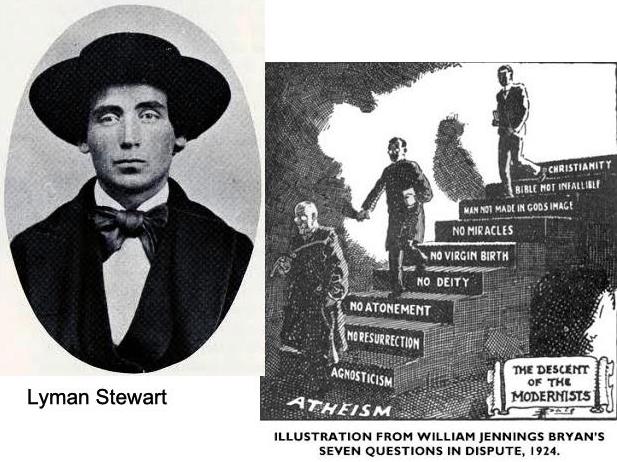
By the term fundamentalist Kivisto is referring to movements that grew out of those who in the 1920s named themselves “fundamentalists” and who identified their ideas with The Fundamentals (biblical inerrancy, miracles, etc) essays published and funded by Southern Californian oil millionaire Lyman Stewart. The Fundamentals identified a good many enemies of “truth”:
- socialism
- feminism
- Darwinism
- Roman Catholicism
- Mormonism
- modern spiritualism
- humanistic psychology
- the Social Gospel
- and theological liberalism
Very often fundamentalists felt obliged to enforce their views on society through political and legal action. Recall the Scopes “monkey trial” of 1925.
Martin Marty, who led a major American Academy of Arts and Sciences project on fundamentalism, offered a succinct account of what fundamentalism is and what it is not:
- “it is not the same thing as conservatism, traditionalism, classicism, or orthodoxy, though fundamentalists associate themselves with such concepts.”
- “most fundamentalists do not conceive of themselves as being antiscientific or antirational on their own terms. . . But most fundamentalist movements dedicate themselves to representing alternative and, in their eyes, ‘proper’ science and reason.”
- “fundamentalists are seldom opposed to technology as such, or to many of its specific artifacts. Technology, one might say, helped make fundamentalism possible.”
- “fundamentalists are not always poor, uneducated people who rationalize their hopeless lower-class circumstances through a religious movement. “Deprivation theories” are among the more discredited explanation today in respect to Fundamentalism. Indeed, many such movements prospered in America as old religious conservative groups moved into the middle class, and it is among the university-educated and professionally mobile Jews, Mormons, Muslims, and others that fundamentalism grows.”
In identifying the core components of fundamentalism, Marty begins by stating that it “is always reactive, reactionary,” forever responding to “perceived challenges and threats” posed by a “force, tendency, or enemy” that is “eroding, corroding, or endangering one’s movement and what it holds dear.” As such, fundamentalism is about defining boundaries, and defining them in bright, not blurred, terms: the world is us against them, with them being a sometimes shifting target. This means, Marty continues, that fundamentalism “is always an exclusive or separatist movement” predicated on beliefs that are defined in absolutist, black-and-white terms. It is for that reason that fundamentalists are dismissive of interfaith or ecumenical understanding and dialogue, opting instead for an oppositional stance against anyone who does not share their worldview. Marty concludes that fundamentalists are inherently absolutist, and, “With absolutism comes authoritativeness or authoritarianism” (Marty, 1988, pp. 20—21). (Kivisto, 93f)
Sociologist Martin Riesebrodt points out that fundamentalists, in their rejection of the world, either elect to withdraw from it or to control it. The latter option often means they seek to impose their beliefs and practices on the world through political activity of various kinds.
The strain of world mastering fundamentalists engaging in American politics since the middle of the past century includes such now largely forgotten figures as Carl McIntyre, a dissident Presbyterian and fervent anti-communist crusader — engaged as he saw it in a civilization struggle between the Christian West and the atheistic core of Soviet communism. He was hostile to anyone seen as fellow travelers, which included groups such as the ecumenically oriented National Council of Churches, making his views known to a radio audience via his “The 20th Century Reformation Hour.” He and like-minded fundamentalists represent the precursors to the contemporary Christian right. (Kivisto, 94)
1970s Movement Mobilization and Christian Nationalism
The two most well known leaders were Pat Robertson and Jerry Falwell. Both evangelized extensively through mass media. Robertson created Regent University and the American Center for Law and Justice, “which aimed to shape legislative agendas and fight judicial battles”. Falwell founding Liberty University in 1971 and Moral Majority in 1979.
Certain issues have been constant ever since the 1970s:
- attempts to overturn the Supreme Court’s 1973 Roe v. Wade decision legalizing abortion
- challenges to the separation of church and state by pressing for school prayer and abstinence-only sex education
Underpinning all of the particular issues preoccupying the Christian right is the conviction that the United States is a Christian nation and that, as the name of Falwell’s organization indicates, the movement represents the beliefs of a majority of the citizenry. At the same time, the Christian right sees itself as under assault from enemies who threaten the cultural integrity of the nation. If the Southern strategy pushed the Republican Party into the camp of white nationalists, the Christian right’s self-understanding is shaped by an ideology of Christian nationalism. (Kivisto, 95)
These “world mastering fundamentalists” set themselves against “liberals, Hollywood, the media, the American Civil Liberties Union, and often, academics”, those they deem to be “enemies” who, because they are “hostile to religion and . . . are antipopulist” are therefore “fundamentally un-American“. [Compare the post on Americanism as an ideology and the treason of “un-Americanism”.] With such an outlook they (the fundamentalists) “reveal their anti-pluralist and thus intrinsically anti-democratic view of politics” (Rhys Williams).
The two targets at the top of the “un-American” list are atheists (more recently those identifying themselves as spiritual but not religious are likewise of serious concern) and Muslims.
The current animus toward Muslims reflects a long history of hostility to other religions, including anti-Semitism, anti-Catholicism, and anti-Mormonism. (Kivisto, 96)
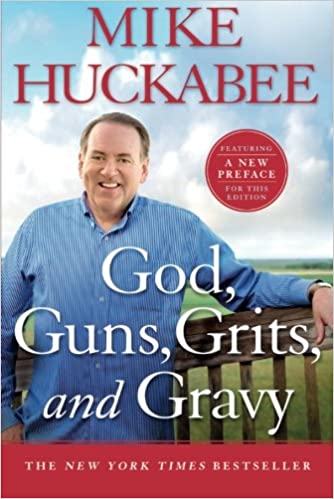 The world according to Huckabee
The world according to Huckabee
The assertiveness — indeed, the militancy — of the insistence on defining America as a Christian nation belies fear that it either no longer actually is or soon may no longer be so. This perspective is on display, for example, in Republican politician Mike Huckabee’s 2015 book, God, Guns, Grits, and Gravy, which bemoans the growing secularization of the nation and the gulf between people of the heartland and liberal elites: the significant linkage in his book’s title involves God and guns, and it is also worth noting that Huckabee was also a program host at the Fox Network for several years. (Kivisto, 96)
The world according to Huckabee is also the world according to the National Rifle Association (NRA):
The world according to Huckabee is also the world according to the National Rifle Association (NRA). The organization was founded shortly after the Civil War in response to the realization by Union officers that their soldiers were terrible marksmen. From that beginning, it developed into an organization devoted to hunting and sports shooting, and defined as part of its purpose to promote gun safety. It was not opposed in principle to gun laws, and thus supported bans on machine guns and sawed-off shotguns under the provisions of the National Firearms Act of 1934. By the 1960s a shift was underway to redefine guns in terms that evoked racial tensions, fear of crime, and other perceived threats to life and limb. Guns were portrayed as essential for law-abiding citizens to protect themselves, and thus any attempt to limit access to weapons was condemned. Michael Waldman, President of the Brennan Center for Justice at New York University and former Director of Speechwriting in Bill Clinton’s administration, in an article on the rise of the NRA, quotes from an article that appeared in Guns & Ammo magazine that claimed that gun control advocates were “criminal-coddling do-gooders, borderline psychotics, as well as Communists and leftists who want to lead us into the one-world welfare state.”
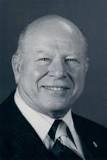 The person who led a coup that ousted the old NRA leaders at a contentious convention in Cincinnati in 1977 was Harlon Carter. Once he was elected executive vice-president of the organization, it was transformed into one that would oppose any gun control measures. Its absolutism riveted on an embrace of the Second Amendment, which had not loomed large in the NRA prior to this hostile takeover. As Waldman points out, “The NRA’s lurch to the right was part of an abrupt shift across the Republican coalition.” 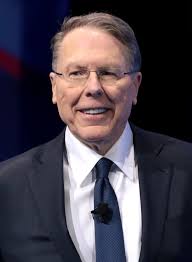 Wayne LaPierre, who took over the role once held by Carter, pushed the NRA even further rightward, its work lobbying to prevent any gun control legislation seamlessly merged with its becoming, in effect, a lobbying arm of the gun industry. And it has been successful, as meaningful gun reform has been stymied since 1996 despite the rash of mass killings that succeed in temporarily — but only temporarily — capturing the nation’s attention (Yanker, 2014). The demographics of both gun ownership and opinions about gun control reveal a stark divide. More than twice as many whites own guns compared to blacks. Likewise, Republicans and conservatives by more than a 2:1 ratio are gun owners compared to Democrats and liberals (Morin, 2014). Furthermore, survey data collected in 2012 found that sizeable majorities of African American Protestants, Catholics, the religiously unaffiliated, and mainline Protestants favored the passage of stricter gun control laws, but only 38% of what the study identified as white evangelical Protestants agreed. Moreover, the more likely respondents were to describe themselves as a “pro-life” Protestant, the less inclined they were to support gun control legislation (PRRI, 2013; see also, Cox & Jones, 2012). They do so despite the fact that, as David Hemenway, Professor of Health Policy at Harvard, has made clear, there is a scientific consensus that “strong gun laws reduced homicide rates” (Hemenway, 2015). And they do so despite the fact, reported by the Centers for Disease Control, that more than 60% of gun-related deaths — approximately 20,000 per year — are suicides (Desilver, 2013).
(Kovisto, 97f — bolded highlighting is mine in all quotations) |
Connecting to Trump
Fact One: he is religiously illiterate
his limited acquaintance with Christianity was at the hands of Norman Vincent Peale, whose “power of positive thinking” amounted to what his biographer Christopher Lane calls “religio-psychiatry,” a vacuous amalgam that was hooked on to a version of Christian nationalism. Peale was roundly criticized by theologians such as Reinhold Niebuhr and by the psychiatric profession. In terms of his politics, he was an opponent of the New Deal welfare state and his strident anti-Catholicism led him to depict the candidacy of John Kennedy as a threat to the nation.
Fact Two: he needed to pander to this segment of the Republican base in order to win both the nomination and the election
it is not surprising that a mutual attraction developed between Trump and various big names associated with the prosperity gospel such as Detroit megachurch pastor Wayne T. Jackson and Florida-based Paula White and latter-day incarnations of the power of positive thinking such as Joel Osteen. First, all of these religious entrepreneurs share Trump’s salesmanship directed at an audience they know how to impress, and his embrace of a luxury lifestyle. Second, at the level of their respective business ventures, the parallel between their organizations and the Trump Organization is striking. And, for that matter, for the more overtly political leaders of the contemporary Christian right, there is another parallel worth noting. Just as Trump’s closely held and opaque family business is intergenerational, with the fourth generation being groomed to take over, so too are several of the prominent Christian right organizations lucrative family operations passed from father to son — from Pat to Gordon Robertson, from Jerry to Jerry Falwell, Jr., and from Billy to Franklin Graham.
Falwell Jr endorses Trump:
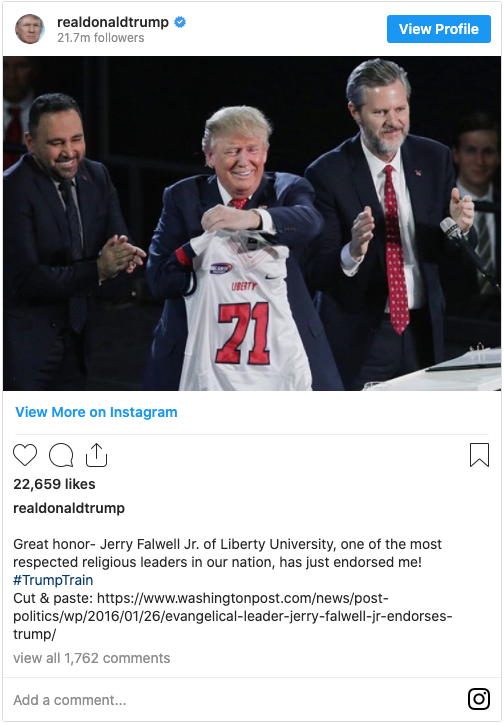 Falwell quoted in Politico:
Falwell quoted in Politico:
In my opinion, Donald Trump lives a life of loving and helping others as Jesus taught in the great commandment, he said
and
Then James Dobson:
So here we are. . .
Next, the Tea Party and reactions to Obama’s presidency.
Kivisto, Peter. 2017. The Trump Phenomenon: How the Politics of Populism Won in 2016. Bingley, UK: Emerald.
If you enjoyed this post, please consider donating to Vridar. Thanks!

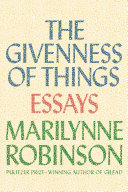

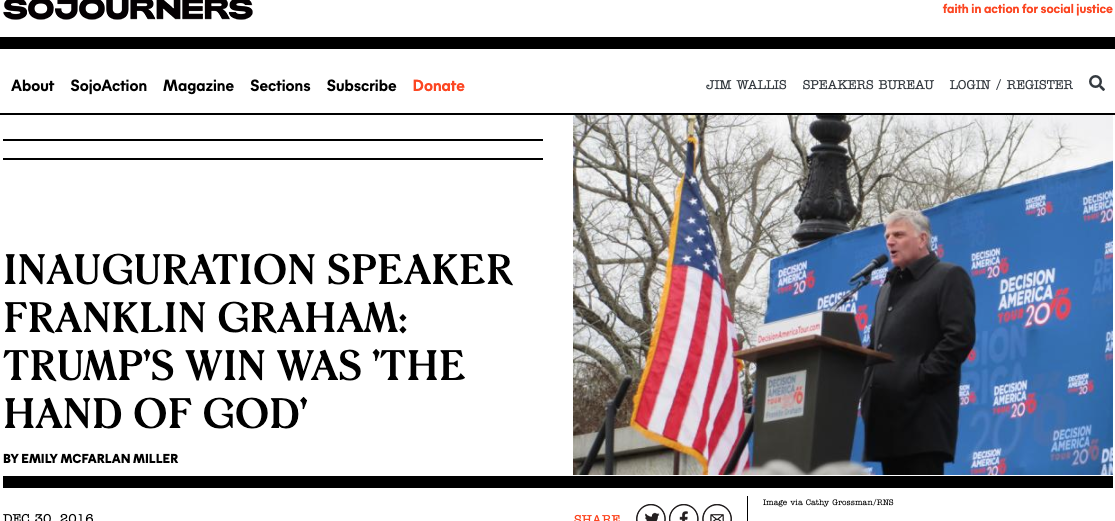
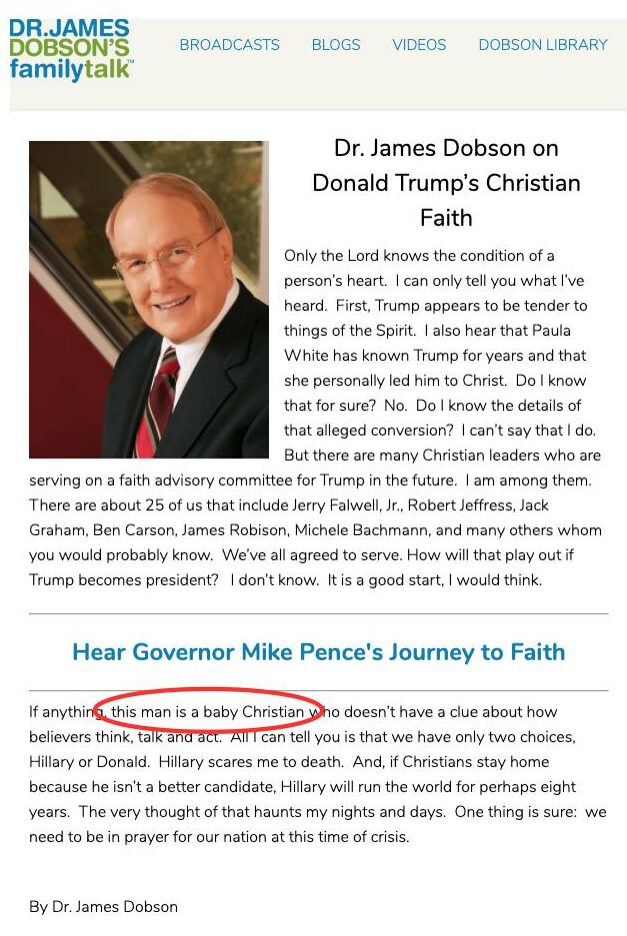
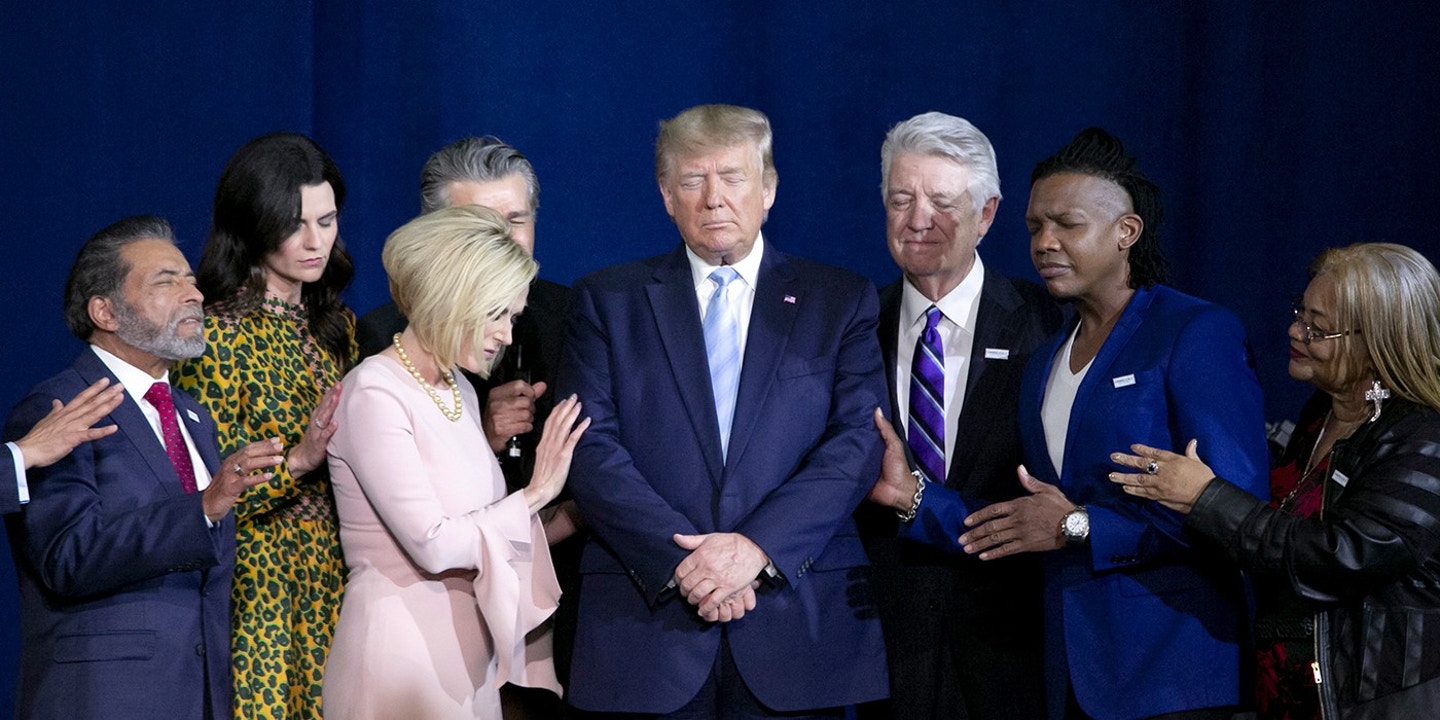
“The enemies of fundamentalisms everywhere are relativism, pluralism, ambiguity.” So when the world is complicated, diverse, and uncertain, you find ways to deny complication, diversity, and uncertainty. If climate change is frightening, you deny it and pretend it doesn’t exist. If you don’t like immigrants speaking Spanish around you, you build a wall on the southern border and that will keep them out. If abortion is troubling, you appoint judges who will reverse Roe, and that will fix the problem. If North Korea scares you, get a president who will threaten them with nuclear annihilation, then make friends with Kim, then ignore the whole thing, and pretend like everything is OK now. The problem is, climate change will get worse; a wall won’t prevent illegal immigration; reversing Roe won’t stop abortions; and North Korea is still there. And so on.
There is also the eye-opening account of American religious historian Randall Balmer, Thy Kingdom Come (2006), in which the emergence of the evangelical right to political engagement–to become the most important voter base of the Republican Party in America–began out of the Bob Jones University case in which evangelicals rallied to defend BJU’s right to have racist policies against a godless federal government which threatened to remove BJU’s tax exemption if it did not comply with federal civil rights policies. The fundamentalist Bible college Bob Jones University of Greenville, South Carolina, had a rule against interracial dating based on a theological belief that segregation was the will of Almighty God. For the purpose of preventing the dread specter of black-white dating, until 1971 BJU had excluded African Americans from admission altogether on the basis of their skin color, then allowed married-only black student admissions until 1975 when unmarried black student admissions were for the first time allowed, but even after 1975 the BJU policy continued of no interracial dating allowed for its students. The US government said, “either comply with US civil rights law and end your race-based student policies, or lose your federal tax exemption.” Evangelicals nationwide organized to resist this encroachment of an unholy state into the god-given right of a Christian private institution to have whatever racist policies they felt like. Most evangelicals claimed they defended BJU not because they supported segregation but over the issue of federal overreach. BJU lost their tax exemption which cost them dearly financially and the case went all the way to the US Supreme Court where BJU lost. In 2000 on a Larry King radio show, BJU president Bob Jones III announced the formal end of their racist policy–that which had cost them a ton of money by refusing to end it–claiming disingenuously that the no-blacks and no-interracial dating policies in the school’s history never had been a big deal to anyone and never had anything to do with being racist.
In announcing BJU’s change in policy concerning interracial dating, BJU president Bob Jones III explained on a Larry King radio program in 2000 (it is worth looking up the transcript on that–it is really wild): “No, we can’t back it up with a verse from the Bible. We never have tried to. We have never tried to do that. But we have said there is a principle here, an overriding principle of the one world government.”
Once the BJU segregation evangelical cause celebre was lost, rather than disband the political infrastructure organized to defend BJU a conscious decision was made to find a different issue and retain political momentum, and the issue chosen was the hugely successful issue of abortion, as brought out in Balmer, Thy Kingdom Come.
I was a student in the 1970s at a fundamentalist Christian Bible college, Ambassador College in Big Sandy, Texas, which had practically identical policies and theological underpinning on racial issues as BJU. While claiming and sincerely understanding itself not to be racist and that God loved all people of all colors equally spiritually (the culture was ideologically pro-segregation but anti-hate speech), until 1971 unmarried African-American applicants to Ambassador College had been refused admission on the grounds of their skin color. (Married African Americans had been admitted for some years, on the theory that they did not pose the threat of interracial dating.) Starting rushed and last-minute the fall of 1970 at the headquarters campus in Pasadena, California, and then in a more orderly way in 1971 at the Big Sandy, Texas campus, with no explanation given to church members as to why, unmarried African-American applicants were admitted to these two AC campuses for the first time. I arrived to the Texas campus in the fall of 1972, after the color barrier had been broken at that campus. Nobody was told why–we all thought the no-unmarried-blacks-admissions rule had been changed simply because it was the right thing to do, or in general terms because of changing attitudes in America. It was not until many years later that I realized that the same US government ultimatums given to Bob Jones University in the timeline of warnings issued to all church colleges which had race-based admissions-exclusion policies–was the context and the reason for the changes which had happened at AC just before I arrived. The only difference was AC, on the advice of its legal counsel, had chosen to quietly comply rather than choose resistance as did BJU. A third Ambassador College campus, Bricket Wood in England, however, did not change policy–that campus never did admit unmarried African students–that was because it was out of reach of US tax authorities. The change of policy at only the two US campuses of Ambassador College, and not the one in the UK, illustrates the US Government ultimatum behind the admissions policies changes in the US campuses as the controlling variable.
From the Balmer book (https://www.npr.org/templates/story/story.php?storyId=5502785):
“[Paul Weyrich, an architect of the Religious Right of the 1980s] said animatedly, that the Religious Right did not come together in response to the Roe decision. No, Weyrich insisted, what got us going as a political movement was the attempt on the part of the Internal Revenue Service (IRS) to rescind the tax-exempt status of Bob Jones University because of its racially discriminatory policies.
“Bob Jones University was one target of a broader attempt by the federal government to enforce the provisions of the Civil Rights Act of 1964. Several agencies, including the Equal Employment Opportunity Commission, had sought to penalize schools for failure to abide by antisegregation provisions. A court case in 1972, Green v. Connally, produced a ruling that any institution that practiced segregation was not, by definition, a charitable institution and, therefore, no longer qualified for tax-exempt standing.
“The IRS sought to revoke the tax-exempt status of Bob Jones University in 1975 because the school’s regulations forbade interracial dating; African Americans, in fact, had been denied admission altogether until 1971, and it took another four years before unmarried African Americans were allowed to enroll. The university filed suit to retain its tax-exempt status, although that suit would not reach the Supreme Court until 1983 (at which time, the Reagan administration argued in favor of Bob Jones University). […]
“The Religious Right arose as a political movement for the purpose, effectively, of defending racial discrimination at Bob Jones University and at other segregated schools. Whereas evangelical abolitionists of the nineteenth century sought freedom for African Americans, the Religious Right of the late twentieth century organized to perpetuate racial discrimination. Sadly, the Religious Right has no legitimate claim to the mantle of the abolitionist crusaders of the nineteenth century. White evangelicals were conspicuous by their absence in the civil rights movement of the 1950s and 1960s. Where were Pat Robertson and Jerry Falwell and Billy Graham on August 28, 1963, during the March on Washington or on Sunday, March 7, 1965, when Martin Luther King Jr. and religious leaders from other traditions linked arms on the march from Selma to Montgomery, Alabama, to stare down the ugly face of racism?
“Falwell and others who eventually became leaders of the Religious Right, in fact, explicitly condemned the civil rights movement. ‘Believing the Bible as I do,’ Falwell proclaimed in 1965, ‘I would find it impossible to stop preaching the pure saving gospel of Jesus Christ, and begin doing anything else—including fighting Communism, or participating in civil-rights reforms.'”
YES, this is a very important point. It is vital to recognize that while every conventional account of the so-called Religious Right ritually cites Roe v. Wade as the origin of the movement, this is just an ex post facto rationalization for a movement whose basic shape was already taking form. The true catalyst was Brown v. Board.
The true novelty of the Religious Right in its canonical Reagan-era form was the alliance between white Catholics and white Protestants who had traditionally been hostile to each other – so-called “white ethnics” (a phrase that is usually code for Catholic) were traditionally a core Democratic constituency while the Republicans represented the Protestant majority. The domestic issue that brought them together was control of schools. Catholics in the United States were long hostile to public schools dominated by a Protestant educational establishment; Catholic educational separatism is a familiar feature of the landscape throughout the United States (the ubiquitous private Catholic schools). Among the effects of the civil rights struggle was to convert racist white Protestants to a similar siege mentality. After Brown, racist white Protestants self-segregated from the Godless public schools because they wanted to perpetuate the Jim Crow model of conservatism – and suddenly discovered a common interest with the Catholics who had been practicing a similar self-segregation all along. This alliance was bolstered by the simultaneous invention of the myth of “Judeo-Christian civilization” to justify Cold War policies. American Protestants and Catholics could feel that their alliance was merely one part of a global struggle; the civil rights movement was allegedly allied with Godless Communism to destroy Western civilization and the American way of life.
One of the major benefits this alliance provided to Protestant fundamentalists was that it gave them intellectual cover. Instead of blatantly re-enacting the Scopes trial, the anti-intellectualism of fundies could be smuggled into law by piggybacking off the Catholic intellectuals, who were better-educated and capable of much subtler casuistries. This pragmatic embrace of Catholics has revolutionized the Republican legal establishment, which Catholics utterly dominate today: if you look at the Supreme Court, the Republican Justices are ALL Catholics and have been for years. (The exception that proves the rule is Neil Gorsuch, who is Catholic in all but name; he was born a Catholic and educated in Catholic schools, switching to the Anglican Church only after his marriage.) The Catholic presence is in fact a major running thread throughout the intellectual and institutional history of the Religious Right, from William F. Buckley and Paul Weyrich to Robert Bork, Clarence Thomas and Leonard Leo. Even Ayn Rand, a notorious atheist, professed to admire Aquinas above all modern thinkers. The whole dynamic is that the GOP’s still largely Protestant voter base hides behind these Catholic or Catholic-adjacent intellectuals who make their livings by finding ways to dress up the prejudices of white conservatism in facially-plausible “religious freedom” garb that sounds more palatable to the majority. Abortion is merely a convenient excuse to be brought up when someone calls them on it; the serious anti-abortioniks are only a minority.
I (coming from midwest mainline-Protestant roots originally [Methodist]) do not really see an evangelical protestant/Catholic-intellectual alliance. Certainly conservative Catholic intellectuals are a force in conservative political thought, but I do not think the organized evangelical-protestant voter base of the Republican Party is led by, or much cares, what Catholic intellectuals say, such as the late William F. Buckley (though you are right Clarence Thomas is favorably regarded among the evangelical right).
Conservative Catholic intellectuals are, well, intellectual. The evangelical right has a culture and history of anti-intellectualism. That is one core difference. Another is the postmillennialism of Catholic ideology (both of left and right Catholics)–the Christian Church will bring about the kingdom of God on earth through reasonable and pragmatic means–contrasted to the premillennialism/magical-thinking of the evangelical right, in which history is viewed as culminating in imminent apocalyptic conflagration and a Star Wars-evocative rapture and Return of Christ as the way current world travails will turn out happily ever after in the end.
Abortion or pro-life is shared in common, but there are differences in approach here. Left-Catholics see pro-life in the context of a larger humanitarian or social-concern focus structured through government agency, i.e. progressive or pro-life Democrats. Conservative Catholics by and large, while anti-abortion, seem not to have made abortion a #1 focus in the way that has been a central organizing issue of the American evangelical right, i.e. lower level of proselytising about the pro-life issue than evangelicals.
You are right that Catholics (both liberal and conservative) share with evangelicals primary- and secondary-education-separatism impulses–with Catholics, private schools typically of high reputation for quality of education; with evangelicals, the home schooling movement. But there is very little cross-fertilization that I can see. I see virtually no evangelicals sending their children to Catholic schools, nor any groundswell of support for the home-schooling movement among Catholics, nor much interaction between the respective educational systems.
America’s two major parties, Democratic and Republican, are each big tents with not everyone in either tent for the same reasons. A majority of Catholics are Democratic, and a majority of evangelical Protestants are Republican. But there are conservative Catholics who are Republican, and there are left-evangelicals (which used to be traditional evangelicals of America’s earlier history, Social Gospel evangelicals, Martin Luther King evangelicals, Jimmy Carter evangelicals–the idea that Jesus cared about poor and marginalized people) who are Democrats.
Roman Catholicism is “high church”–tradition and history, great cathedrals, high art, cardinals and liturgy, ecclesiastical wealth. Evangelicals are “low church”, informal and populist, cultural disdain for history and authority and hierarchy, not much interest in high art or tradition or monumental architecture. Classical and Gregorian chants for Roman Catholics, Christian rock and guitars for evangelicals…
Catholicism is transplanted Old World, more of an international world-embracing outlook. Evangelicals in America self-identify as American frontier and American exceptionalism, city on a hill, divine chosen-nation status, poor knowledge of and little interest in other peoples of the world apart from as missionary conversion-objects…
Finally, Trump. According to a Public Religion Research Institute poll of May 2020, only 37% of white Catholics support Trump, whereas Trump 2016 enjoyed the support of 81% of white evangelicals and today holding strong at around two-thirds, his most important voter base. Trump is the evangelical right’s MAN, embraced with quasi-messianic cult fervor as no previous president. I suspect the 37% of white Catholics who support Trump do so for different reasons related to abortion, economic, or conservative-ideology reasons, with relatively little personality-cult factor centered around the person of Trump of the mindset of many evangelicals.
These are reasons why I do not see a significant alliance between conservative Catholics and the evangelical right in American politics, despite both being present in the Republican Party. They are not adversaries or hostile to each other, just to a large extent operating in two different universes. My take on it anyway.
On your opening comment about the true catalyst being Brown v. Board, not Roe v. Wade, could be, interesting.
Such mindless drivel. You hate Christians for no reason just like the Bible says. You twist everything you wicked scum. You know Mike Huckabee is a kindhearted person yet you act like he’s your enemy. You people are sick. You attack the right as if we don’t have a right to have representation in this country. Your ignorance of history is sickening. Scopes trial was brought to bring publicity not to force fundamentalist beliefs; I think you know that too. You people live by propaganda. Wake Up. The second amendment says there shall be NO INFRINGEMENT. Stop pretending that our constitution isn’t flagrantly trampled on by the left. The right have given to every leftist drive against our liberty since the NEW Deal. Stop pretending your way of life is under threat. You royal scum.
Yet the Scopes Trial arose in response to a law (the Butler Act), which did exist in order to force fundamentalist beliefs: being precise, the Butler Act (Tenn. HB 185, 1925) specifically provided: “That it shall be unlawful for any teacher in any of the Universities, Normals and all other public schools of the State which are supported in whole or in part by the public school funds of the State, to teach any theory that denies the Story of the Divine Creation of man as taught in the Bible, and to teach instead that man has descended from a lower order of animals.”
Mike Huckabee from middle of the night infomercials is kindhearted? I thought he was just another Elmer Gantry grifter. https://www.ispot.tv/ad/OsPW/relaxium-good-night-sleep-featuring-mike-huckabee & this classic: https://www.ispot.tv/ad/nHU3/international-fellowship-of-christians-and-jews-genocide-featuring-mike-huckabee